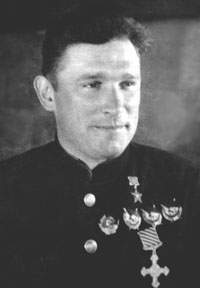
Aviation of World War II


 |
Aviation of World War II |


|
|
Soviet Union | Lend - Lease | Facts | Forum | Germany | Japan | R A F | U S A A F | Other | Photos |
|
Facts | People | Engines | Aces | Aircraft Handbook | WWII Periodicals | Contact | |
Boris Safonov and I-16Was there an inscription 'For Stalin!' by Boris Safonov's plane

Boris Feoktistovich Safonov, Lieutenant Colonel
However, is it so? Yuri Rybin's analysis allows us to conclude that this is not the case. The first four I-16 type 24 (No. 24P218-91, 24P218-100, 24P219-3 and 24P219-4) appeared in the Northern Fleet Air Force in early April 1941. On the basis of these four "donkeys" on April 10, a training group was formed as part of the 72nd SAP, which included 20 young pilots who had arrived in the Arctic the day before from various military schools. In fact, it was a training squadron in which young pilots mastered a new fighter for themselves. The newly formed squadron was led by the 26-year-old senior lieutenant Safonov. By the way, this is where the myth was born that B. Safonov was the "father" of a large galaxy of North Sea aces. On April 16, during training flights on landing due to engine failure, I-16 # 24R218-91 (pilot junior lieutenant Zhivotovsky) crashed. Therefore, by June 22, three I-16s remained in service. On one of them on June 24, in the second combat mission since the beginning of the war, Boris Safonov shot down a Ju-88. Judging by the numerous articles of that period, it was on this day that the inscriptions "Death to fascism!". Appeared on board the first Safonov I-16 and "For the All-Union Communist Party (Bolsheviks)!" ("Krasnoflotets" No. 149 dated June 26, 1941). 
The example was contagious. The sides of the other two I-16s were also decorated with combat calls: on the I-16 of senior lieutenant A.A. Kovalenko with tactical number "11" there were inscriptions "For Stalin!" and "For Communism!" ("Krasnoflotets" No. 235 dated September 20, 1941); on the I-16 with the tail number "13", in the cockpit of which S.Surzhenko was photographed, the inscription "For the USSR!" (it is not known if there was any inscription on the other side of this aircraft). On June 26, that is, even before the start of active hostilities in the Murmansk direction, the combat strength of the 72nd SAP was significantly replenished with twelve I-16 type 24. On June 29, on the first day of the German offensive in the Arctic, the regiment lost five I- 16 from this batch. But already on July 10, the fighter aviation of the Northern Fleet was reinforced again - ten I-16s arrived in the 72nd SAP, half of which were of the 28th type. One of these cannon fighters was chosen by Boris Safonov - it was I-16 type 28 # 2821 3 95. On this plane, the North Sea ace fought from July 10 to October 3, 1941. On July 10, Safonov made four sorties, and it is possible that some of them were carried out by him on the I-16 type 28 he just received. By the way, on the same day, the squadron commander of the 72nd Safonov was awarded the next military rank "captain" ... From July 10 to October 3, Boris Safonov made 145 sorties, conducted 27 air battles and recorded 13 downed enemy aircraft on his combat account. Of these sorties, 109 were performed on the I-16 # 2821 3 95. Hence we can conclude that Safonov sometimes flew on other "donkeys" of the 72nd SAP. Next, the question arises, whether Safonov "transferred" his military appeals to the "new" fighter? Absolutely everyone who knew Boris Safonov well said that he did not like ostentation. His character was characterized by seriousness and efficiency in everything. The euphoria of the first days, when it seemed that everything would end quickly, as in the pre-war forecasts, “with little blood and on foreign territory”, with the beginning of active hostilities on the ground and in the air, it quickly disappeared. The situation at the front by July 10, when Safonov "moved" to another I-16, was hardly conducive to taking up the brush again and "decorating" his fighter with spectacular slogans. Despite the fact that Safonov was repeatedly photographed after his first aerial victory throughout the summer, it seems strange that there is not a single photograph where he was captured at the I-16 with the words "Death to fascism!" or "For the All-Union Communist Party (Bolsheviks)!" Most likely, when the newspaper needed a photo of the first North Sea ace, military correspondent Yevgeny Khaldey took pictures of Boris Safonov not from his plane, but from I-16 Alexander Kovalenko with a military appeal "For Stalin!" However, it can be assumed that there were inscriptions on Safonov's second plane, but could they have survived on the fighter after its owner moved to the Hurricane? On October 3, 1941, Boris Safonov took to the skies for the last time in his "donkey", having taken off as part of a flight of three I-16s for weather reconnaissance. The next sortie, on October 16, already during the formation of the new 78th Fighter Aviation Regiment, he made on the English Hurricane fighter. |